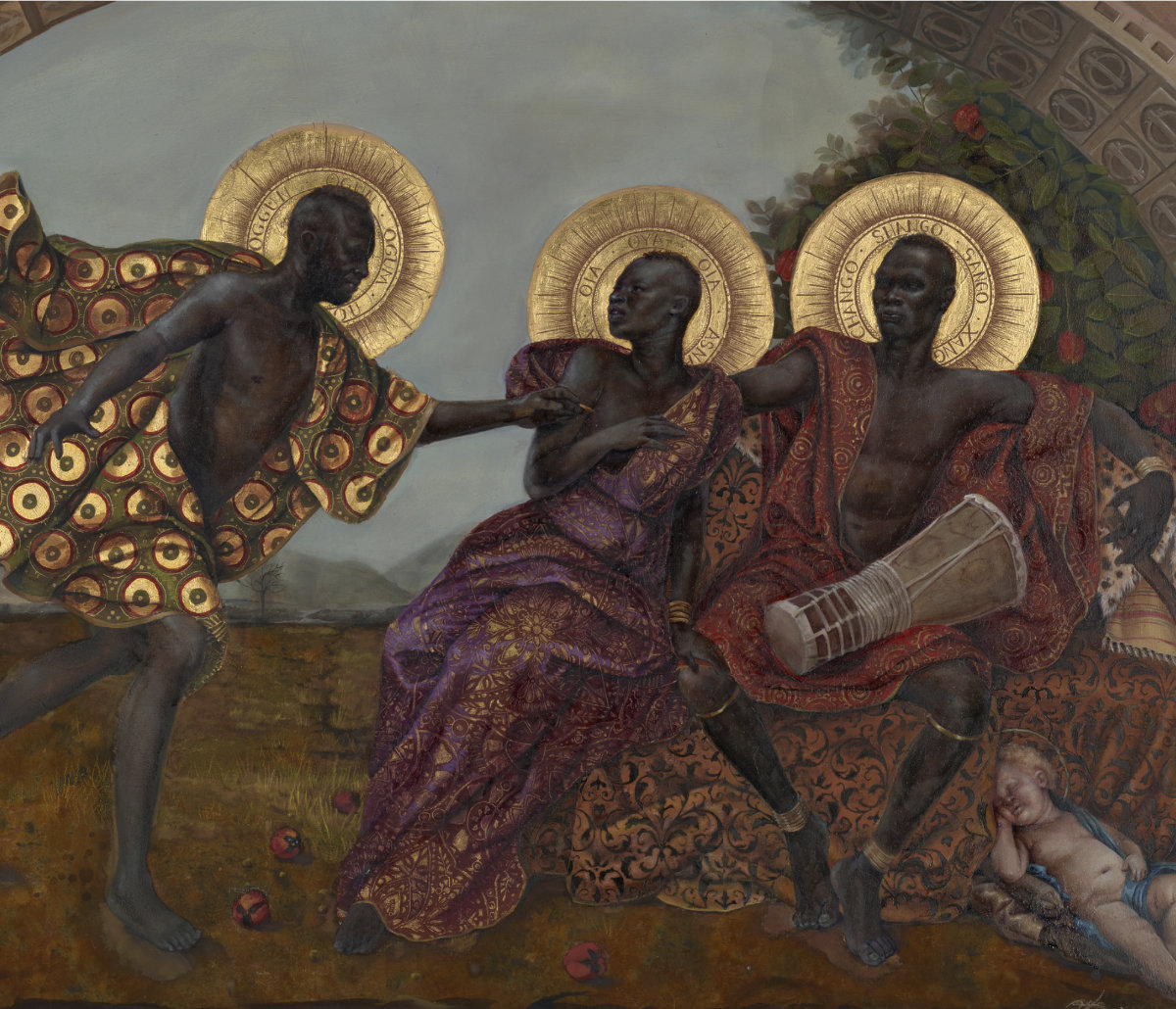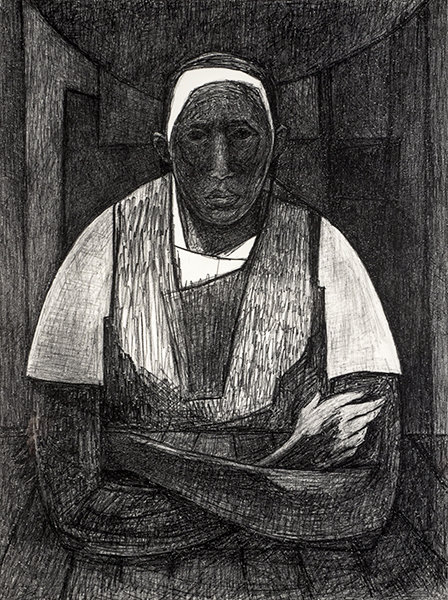Shango, also known as Ṣàngó, Changó, Xangô, Jakuta, and Badé, is an Orisha, a deity in Yoruba religion. Genealogically speaking, Shango is a royal ancestor of the Yoruba, as he was the third Alaafin of the Oyo Kingdom prior to his posthumous deification. Shango has numerous manifestations, including Airá, Agodo, Afonja, Lubé, and Obomin. He is known for his powerful double axe (Oṣè). He is considered to be one of the most powerful rulers that Yorubaland has ever produced. In the New World, he is syncretized with either Saint Barbara or Saint Jerome. Ṣàngó was the third Alafin of Oyo, following Oranmiyan and Ajaka. He brought prosperity to the Oyo Empire. According to Professor Mason’s Mythological Account of Heroes and Kings, unlike his peaceful brother Ajaka, he was a powerful and violent ruler. He reigned for seven years which were marked by his continuous campaigns and many battles. His reign ended due to his inadvertent destruction of his palace by lightning. He had three wives, namely Queen Oshun, Queen Oba, and Queen Oya. The Oyo Empire fell into civil war in the 19th century. It lost Ilorin when the Fulani and Hausa soldiers of Afonja led a successful revolt. Some of the slaves brought to the Americas were Yoruba, one of the various ethnic groups drawn into the Atlantic Slave trade, and they brought the worship of Ṣàngó to the New World as a result. Strong devotion to Ṣàngó led to Yoruba religions in Trinidad and Recife, Brazil being named after the deity. In Yorubaland, Ṣàngó is worshiped on the fifth day of the week, which is named Ojo Jakuta. Ritual worship foods include guguru, bitter cola, àmàlà, and gbegiri soup. Also, he is worshiped with the Bata drum. One significant thing about this deity is that he is worshiped using red clothing, just as he is said to have admired red attire during his lifetime. Ṣàngó is viewed as the most powerful and feared of the orisha pantheon. He casts a “thunderstone” to earth, which creates thunder and lightning, to anyone who offends him. Ṣàngó is venerated in Santería as “Changó”. Ṣàngó is known as Xangô in the Candomblé pantheon. He is said to be the son of Oranyan, and his wives include Oya, Oshun, and Oba, as in the Yoruba tradition. Xangô took on strong importance among slaves in Brazil for his qualities of strength, resistance, and aggression. He is noted as the god of lightning and thunder. He became the patron orixa of plantations and many Candomblé terreiros. In contrast Oko, the orixá of agriculture, found little favor among slaves in Brazil and has few followers in the Americas. The main barracão of Ilê Axé Iyá Nassô Oká, or the terreiro Casa Branca, is dedicated to Xangô. Xangô is depicted with an oxê, or double-sided ax similar to a labrys; and a brass crown.
| Alias Shango, Ṣàngó |
| Real Names/Alt Names Shango, Ṣàngó, Changó, Xangô, Jakuta, Badé |
| Characteristics Hero, Politician, Deity, Electricity Manipulator, Prehuman Epoch, African |
| Creators/Key Contributors Unknown |
| First Appearance Yoruba mythology |
| First Publisher ○ |
| Appearance List The Yoruba-Speaking Peoples of the Slave Coast of West Africa (1894) by A. B. Ellis; The History of the Yorubas (1921) by Samuel Johnson; Os africanos no Brasil (1932) by Raymundo Nina Rodrigues; Xangôs do Nordeste: investigações sobre os cultos negro-fetichistas do Recife (1937) by Albino Gonçalves Fernandes; Candomblés da Bahia (first ed. 1948; 2nd ed. 1954) by Edison Carneiro; West African Religion (1949) by Geoffrey Parrinder; Dieux d’Afrique (1954) by Pierre Verger (original edition; later reissued); Olódùmarè: God in Yoruba Belief (1962) by E. Bolaji Idowu; “The Symbolism and Ritual Context of the Yoruba ‘Laba Shango'” in Journal of the Royal Anthropological Institute (1962) by Janice Wescott & Peter Morton-Williams; Three Yoruba Plays (1964) by Duro Ladipo — includes Oba Kóso (canonical Sàngó drama); The Shango Cult in Trinidad (1965) by George Eaton Simpson (monograph; first ed. 1965); Yoruba Beliefs and Sacrificial Rites (1979) by J. Ọmọṣade Awolalu. |
| Sample Read Yoruba Beliefs and Sacrificial Rites (1979) [Internet Archive] |
| Description Shango, also known as Ṣàngó, Changó, Xangô, Jakuta, and Badé, is an Orisha, a deity in Yoruba religion. Genealogically speaking, Shango is a royal ancestor of the Yoruba, as he was the third Alaafin of the Oyo Kingdom prior to his posthumous deification. Shango has numerous manifestations, including Airá, Agodo, Afonja, Lubé, and Obomin. He is known for his powerful double axe (Oṣè). He is considered to be one of the most powerful rulers that Yorubaland has ever produced. In the New World, he is syncretized with either Saint Barbara or Saint Jerome. Ṣàngó was the third Alafin of Oyo, following Oranmiyan and Ajaka. He brought prosperity to the Oyo Empire. According to Professor Mason’s Mythological Account of Heroes and Kings, unlike his peaceful brother Ajaka, he was a powerful and violent ruler. He reigned for seven years which were marked by his continuous campaigns and many battles. His reign ended due to his inadvertent destruction of his palace by lightning. He had three wives, namely Queen Oshun, Queen Oba, and Queen Oya. The Oyo Empire fell into civil war in the 19th century. It lost Ilorin when the Fulani and Hausa soldiers of Afonja led a successful revolt. Some of the slaves brought to the Americas were Yoruba, one of the various ethnic groups drawn into the Atlantic Slave trade, and they brought the worship of Ṣàngó to the New World as a result. Strong devotion to Ṣàngó led to Yoruba religions in Trinidad and Recife, Brazil being named after the deity. In Yorubaland, Ṣàngó is worshiped on the fifth day of the week, which is named Ojo Jakuta. Ritual worship foods include guguru, bitter cola, àmàlà, and gbegiri soup. Also, he is worshiped with the Bata drum. One significant thing about this deity is that he is worshiped using red clothing, just as he is said to have admired red attire during his lifetime. Ṣàngó is viewed as the most powerful and feared of the orisha pantheon. He casts a “thunderstone” to earth, which creates thunder and lightning, to anyone who offends him. Ṣàngó is venerated in Santería as “Changó”. Ṣàngó is known as Xangô in the Candomblé pantheon. He is said to be the son of Oranyan, and his wives include Oya, Oshun, and Oba, as in the Yoruba tradition. Xangô took on strong importance among slaves in Brazil for his qualities of strength, resistance, and aggression. He is noted as the god of lightning and thunder. He became the patron orixa of plantations and many Candomblé terreiros. In contrast Oko, the orixá of agriculture, found little favor among slaves in Brazil and has few followers in the Americas. The main barracão of Ilê Axé Iyá Nassô Oká, or the terreiro Casa Branca, is dedicated to Xangô. Xangô is depicted with an oxê, or double-sided ax similar to a labrys; and a brass crown. |
| Source Shango – Wikipedia |


